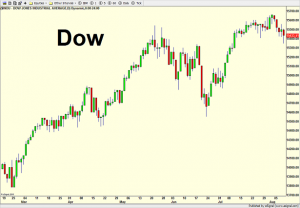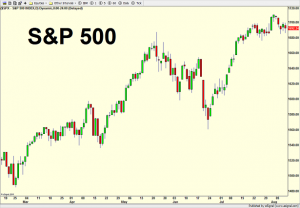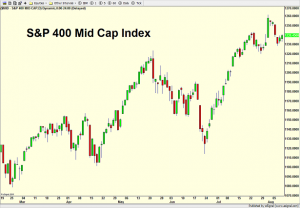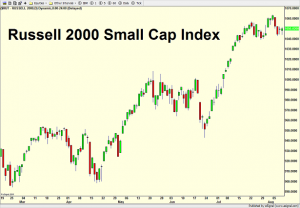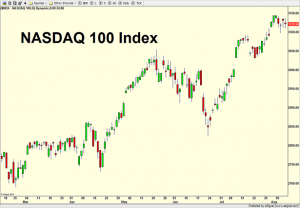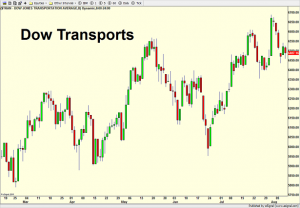Canaries Still Breathing Okay
I haven’t done a canaries in the coal mine update in a while, but with the major market indices hitting fresh highs last week, it’s time to check if any are dead. Remember, canaries in the coal mine are only useful at bull market peaks and bear market troughs. In other words, they are very helpful at spotting beginnings and endings of bull markets, but not much in between. They are so important because they usually give ample warning that a bull market is living on borrowed time as the canaries begin to die.
Let’s start with the major indices as they should all be in new high or fresh highs for 2013 territory. The Dow is first and you can see the all time from last week on the right side of the chart.
The S&P 500 (very large companies) is next and it, too, hit all time highs last week.
The S&P 400 (medium size companies) is below and it is in line with the first two from above. The S&P 400 is usually the big leader during the mid stages of the bull market as many companies in this index experience their glory years or growth and financial stability.
The Russell 2000 (small companies) is next it saw all time highs last week. This has been the index leader since the June 24 low and pretty much entire bull market from 2009. There have been a few warning signs along the way, but they keep repairing themselves to health.
The technology laden NASDAQ 100 is the final major index and it has done a remarkable job at playing catch up, not only in the very short-term (since mid July) but also over the past year or so.
In summary, all major stock market indices recently saw fresh highs indicating that the bull market is not close to ending.
The Dow Jones Transportation Index is below and this serves two purposes. First, it’s a minor index after we look at the major ones. Second, old school Dow Theory offers that the Dow Industrials and Transports should be in sync during major rallies and declines to confirm the long-term trend. At bull market peaks like 2007 and 2000, we usually see one index fail to confirm the other’s price move. In other words, if this bull market were ending, we would either see the Industrials or Transports fail to make their final price peaks together. At this point, that’s not the case.
Turning to the bellwether sectors, the banks continue to lead and see new highs on each successive push higher in the stock market. This is healthy action. On a separate note as I mentioned on CNBC’s Closing Bell last week, the banks remain one of the most unloved sectors in the market in spite of their huge price gains and leadership role. I am not a fundamental researcher, but if investors can look past the major players like J.P. Morgan, Citi and Wells Fargo where new government regulation may present some head winds, the regional banks and small banks may present some good opportunities, especially if a mergers and acquisitions wave begins.
With overall sentiment towards the banks negative, this group should continue its leadership role and be a good buy candidate after market declines.
The semiconductors present a much different picture. They are so vitally important because of their leadership in the technology sector and technology’s leadership in the overall stock market. The semis not only are a long-term canary, but also have some good predictive power for intermediate-term moves, something that would make a good article for the next issue.
I have to admit that this group can be a bit frustrating at times because it gives more warnings than any other canary and the only warning that really matters for the end of a bull market is the final one. As you can see below, the semis did NOT see fresh highs last week and their price is already creeping back into the range we saw during May and June. This is not good behavior and bears watching closely.
The New Stock Exchange cumulative advance/decline line is next. For newer readers, this simply represents the number of stocks that go up and down each day totaled over time. I have found it to be an excellent barometer of liquidity and overall market health even though its warnings can range from a few months to almost two years as we saw in the spring of 1998. Detractors will point to the number of non operating companies that litter the NYSE, but that’s exactly why I find this indicator so useful. Those non common stocks are typically closed end bond funds (CEFs) that are acutely sensitive to interest rates. The combination of common stocks and CEFs has proven to be a valuable long-term indicator when the major stock market indices march higher without the NYSE A/D line.
From the chart below, we see twin peaks in May and July, a very mild warning with price going much higher, but nothing that indicates impending doom. This is another canary that should be closely watched now.
Finally, let’s take a peak at high yield (junk) bonds as depicted by the PIMCO High Yield Fund. You can use any of the major funds or the ETFs. I just choose PIMCO because it is a very large fund with a long track record. Junk bonds are so important because they are acutely sensitive to ripples in the liquidity stream as well as the economy. They are at the bottom of the credit hierarchy and money typically flows out of the sector at the first sign of economic trouble or decrease in liquidity.
You can see how the fund made its high in May and sold off dramatically into June. What is unusual is that this decline occurred without stocks cratering. In fact, high yield bonds saw more carnage than stocks. And as stocks vaulted higher in July and August, the high yield sector could barely muster a rally to get back half of what it lost. This canary appears to be dead for this cycle. If junk bonds rollover again and we the PIMCO fund in the mid 9.40s, I think that will spell at least some short-term trouble for stocks.
In summary, the canaries are generally healthy with only one dead (high yield) and maybe two on heightened observation (semiconductors and NYSE A/D line). Before this bull market ends, I expect to see many more canaries on the dead list.
If you would like to discuss how your portfolio is acting now or could behave if more canaries bit the dust, please contact me directly by hitting REPLY or calling the office at 203.389.3553.

